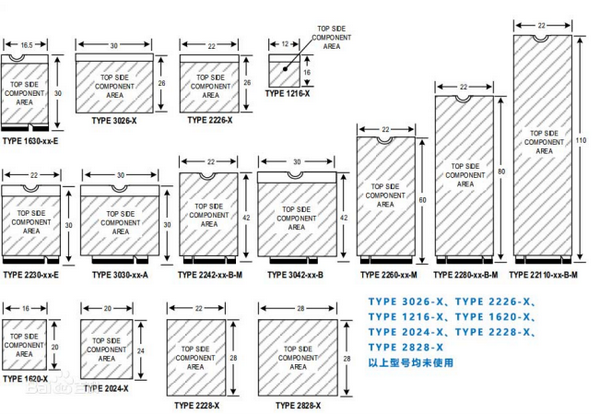What is the M.2 interface?
The M.2 interface is a new interface specification newly launched by Intel to replace MSATA. Simply put, it is a new host interface solution. Compared with the traditional MSATA interface, the M.2 interface is far superior to MSATA in terms of both specification size and transmission performance. However, many people do not know much about this new M.2 interface. Here, I will explain the M.2 interface to you.
M.2 interface specifications
First, let's take a look at the M.2 interface rules: The naming of the M.2 interface mainly follows three principles. The first is the adapter size (length + width); the second is the maximum Z-axis height from the top to the bottom of the adapter; the third is the position of the mechanical connection key. Because there are many naming model series, they are not listed here one by one. A picture is attached for your reference.

Advantages of M.2
Secondly, let's talk about the advantages of M.2 compared to MSATA.
First, let's look at the speed. The M.2 interface mainly has two interface interfaces, B and M. The B interface supports SATA or PCI-E x2 channels, with a maximum read speed of 700MB/S; the M interface supports PCIe x4 channels, with a theoretical bandwidth of 4GB/s, which is 5 times that of the B interface. This shows that the M.2 interface is popular in the market. Secondly, we compare it in terms of volume. Although the MSATA interface is small enough, compared with the M.2 interface, the volume of a single-sided MSATA interface is often much smaller than the overall volume of the M.2 interface.

The difference between B key and M key
Let's make a detailed distinction between the M.2 interface. In addition to the difference in channel speed, the main difference in structural performance is the difference in the position of the notch. The position of the M key interface is on the right, and the position of the B key interface is on the left. Customers can choose the M.2 interface that suits them according to their needs. In the distinction of PCIe bus interfaces, there is actually another interface form, which is the M.2 (B+M) key interface. This interface form can be used in the B key slot, the M key slot, and the B+M slot.
Dual Ports M.2 M+B key 2.5G Ethernet Card
Dual Ports M.2 M+B key Gigabit network Card
Single Port M.2 M+B key 10G Ethernet Card
1. M.2 Interface:
The M.2 interface, also known as Next Generation Form Factor (NGFF), is a compact and versatile connector used for various components in laptops, desktops, and other devices.
It supports different types of modules, including Wi-Fi cards, SSDs, Bluetooth modules, and network cards.
M.2 slots can have different key configurations (B key, M key, or both) to accommodate specific modules.
2. M.2 B Key:
The B key configuration has 5 pins on one side and 6 pins on the other.
It primarily supports SATA-based SSDs, Wi-Fi cards, and Bluetooth modules.
B key slots are typically found in laptops and ultrabooks.
3. M Key:
The M key configuration has 5 pins on both sides.
It supports PCIe-based NVMe SSDs and some Wi-Fi cards.
M key slots are commonly used for high-speed storage solutions.
Remember that the specific functionality of an M.2 slot depends on its key configuration. If you have any more questions or need further clarification, feel free to ask!
Send your message to us:
Post time: Jun-05-2024